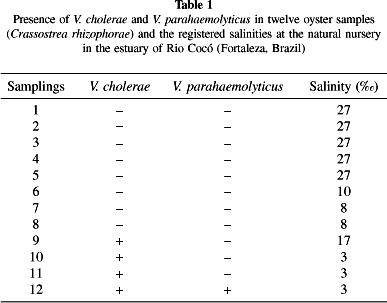Oysters are edible organisms that are often ingested partially cooked or even raw, presenting therefore a very high risk to the consumers' health, especially in tropical regions. The presence of Vibrio cholerae and Vibrio parahaemolyticus in oysters sampled at an estuary in the Brazilian northeastern region was studied, with 300 oysters tested through an 8-months period. The salinity of the water at the sampling point varied between 3% and 27‰. V. cholerae was the most frequently detected species (33.3% of the samples), and of the 22 V. cholerae isolates, 20 were identified as non-O1/non-O139, with two of the colonies presenting a rough surface and most of remaining ones belonging to the Heiberg II fermentation group. V. parahaemolyticus was isolated from just one of the samples. Other bacteria such as Providencia spp., Klebsiella spp. and Morganella morganii were also isolated.
Public health; Vibrio parahaemolyticus; Vibrio cholerae; Oyster; Northeastern Brazil

